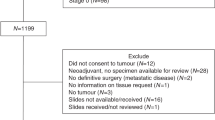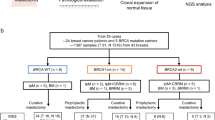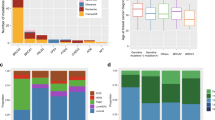Abstract
About 5–10% of breast cancers are hereditary; a genetically and clinically heterogeneous disease in which several susceptibility genes, including BRCA1, have been identified. While distinct tumour features can be used to estimate the likelihood that a breast tumour is caused by a BRCA1 germline mutation it is not yet possible to categorize a BRCA1 mutated tumour. The aim of the present study is to molecularly classify BRCA1 mutated breast cancers by resolving gene expression patterns of BRCA1 and matched sporadic surgical breast tumour specimens. The expression profiles of 6 frozen breast tumour tissues with a proven BRCA1 gene mutation were weighed against those from 12 patients without a known family history but who had similar clinico-pathological characteristics. In addition two fibroblast cultures, the breast cancer cell-line HCC1937 and its corresponding B-lymphoblastoid cell line (heterozygous for mutation BRCA1 5382insC) and an epithelial ovarian cancer cell line (A2780) were studied. Using a high density membrane based array for screening of RNA isolated from these samples and standard algorithms and software, we were able to distinguish subgroups of sporadic cases and a group consisting mainly of BRCA1-mutated breast tumours. Furthermore this pilot analysis revealed a gene cluster that differentially expressed genes related to cell substrate formation, adhesion, migration and cell organization in BRCA1-mutated tumours compared to sporadic breast tumours. © 2001 Cancer Research Campaign http://www.bjcancer.com
Similar content being viewed by others
Article PDF
Change history
16 November 2011
This paper was modified 12 months after initial publication to switch to Creative Commons licence terms, as noted at publication
References
Alberg AJ and Helzlsouer KJ (1997) Epidemiology, prevention, and early detection of breast cancer. Curr Opin Oncol 9: 505–511
Alizadeh AA, Eisen MB, Davis RE, Ma C, Lossos IS, Rosenwald A, Boldrick JC, Sabet H, Tran T, Yu X, Powell JI, Yang L, Marti GE, Moore T, Hudson J Jr, Lu L, Lewis DB, Tibshirani R, Sherlock G, Chan WC, Greiner TC, Weisenburger DD, Armitage JO, Warnke R and Staudt LM (2000) Distinct types of diffuse large B-cell lymphoma identified by gene expression profiling. Nature 403: 503–511
Auffray C and Rougeon F (1980) Purification of mouse immunoglobulin heavy-chain messenger RNAs from total myeloma tumor RNA. Eur J Biochem 107: 303–314
Berns EM, Klijn JG, Smid M, van Staveren IL, Look MP, van Putten WL and Foekens JA (1996) TP53 and MYC gene alterations independently predict poor prognosis in breast cancer patients. Genes Chromosomes Cancer 16: 170–179
Berns EM, van Staveren IL, Look MP, Smid M, Klijn JG and Foekens JA (1998) Mutations in residues of TP53 that directly contact DNA predict poor outcome in human primary breast cancer. Br J Cancer 77: 1130–1136
Biswas DK, Cruz AP, Gansberger E and Pardee AB (2000) Epidermal growth factor-induced nuclear factor kappa B activation: A major pathway of cell-cycle progression in estrogen-receptor negative breast cancer cells. Proc Natl Acad Sci USA 97: 8542–8547
Bittner M, Meltzer P, Chen Y, Jiang Y, Seftor E, Hendrix M, Radmacher M, Simon R, Yakhini Z, Ben-Dor A, Sampas N, Dougherty E, Wang E, Marincola F, Gooden C, Lueders J, Glatfelter A, Pollock P, Carpten J, Gillanders E, Leja D, Dietrich K, Beaudry C, Berens M, Alberts D and Sondak V (2000) Molecular classification of cutaneous malignant melanoma by gene expression profiling. Nature 406: 536–540
Deng CX and Scott F (2000) Role of the tumor suppressor gene Brca 1 in genetic stability and mammary gland tumor formation. Oncogene 19: 1059–1064
Eisen MB, Spellman PT, Brown PO and Botstein D (1998) Cluster analysis and display of genome-wide expression patterns. Proc Natl Acad Sci USA 95: 14863–14868
Foekens JA, Portengen H, van Putten WL, Peters HA, Krijnen HL, Alexieva-Figusch J and Klijn JG (1989) Prognostic value of estrogen and progesterone receptors measured by enzyme immunoassays in human breast tumor cytosols. Cancer Res 49: 5823–5828
Golub TR, Slonim DK, Tamayo P, Huard C, Gaasenbeek M, Mesirov JP, Coller H, Loh ML, Downing JR, Caligiuri MA, Bloomfield CD and Lander ES (1999) Molecular classification of cancer: class discovery and class prediction by gene expression monitoring. Science 286: 531–537
Harris AL, Nicholson S, Sainbury R, Wright C and Farndon J (1992) Epidermal growth factor receptor and other oncogenes as prognostic markers. J Natl Cancer Inst Monogr 11: 181–187
Klijn JG, Berns PM, Schmitz PI and Foekens JA (1992) The clinical significance of epidermal growth factor receptor (EGF-R) in human breast cancer: a review on 5232 patients. Endocr Rev 13: 3–17
Kuenen-Boumeester V, Henzen-Logmans SC, Timmermans MM, van Staveren IL, van Geel A, Peeterse HJ, Bonnema J and Berns EM (1999) Altered expression of p53 and its regulated proteins in phyllodes tumours of the breast. J Pathol 189: 169–175
Lakhani SR, Jacquemier J, Sloane JP, Gusterson BA, Anderson TJ, van de Vijver MJ, Farid LM, Venter D, Antoniou A, Storfer-lsser A, Smyth E, Steel CM, Haites N, Scott RJ, Goldgar D, Neuhausen S, Daly PA, Ormiston W, McManus R, Scherneck S, Ponder BA, Ford D, Peto J, Stoppa-Lyonnet D and Easton DF (1998) Multifactorial analysis of differences between sporadic breast cancers and cancers involving BRCA1 and BRCA2 mutations. J Natl Cancer Inst 90: 1138–1145
Martin AM and Weber BL (2000) Genetic and Hormonal Risk Factors in Breast Cancer. J Natl Cancer Inst 92: 1126–1135
Otterbach F, Bankfalvi A, Bergner S, Decker T, Krech R and Boecker W (2000) Cytokeratin 5/6 immunohistochemistry assists the differential diagnosis of atypical proliferations of the breast. Histopathology 37: 232–240
Papelard H, de Bock GH, van Eijk R, Vliet Vlieland TP, Cornelisse CJ, Devilee P and Tollenaar RA (2000) Prevalence of BRCA1 in a hospital-based population of Dutch breast cancer patients. Br J Cancer 83: 719–724
Paterson JW (1998) BRCA1: a review of structure and putative functions. Dis Markers 13: 261–274
Peelen T, van Vliet M, Petrij-Bosch A, Mieremet R, Szabo C, van den Ouweland AM, Hogervorst F, Brohet R, Ligtenberg MJ, Teugels E, van der Luijt R, van der Hout AH, Gille JJ, Pals G, Jedema I, Olmer R, van Leeuwen I, Newman B, Plandsoen M, van der Est M, Brink G, Hageman S, Arts PJ, Bakker MM and Devilee P (1997) A high proportion of novel mutations in BRCA 1 with strong founder effects among Dutch and Belgian hereditary breast and ovarian cancer families. Am J Hum Genet 60: 1041–1049
Perou CM, Jeffrey SS, van de Rijn M, Rees CA, Eisen MB, Ross DT, Pergamenschikov A, Williams CF, Zhu SX, Lee JC, Lashkari D, Shalon D, Brown PO and Botstein D (1999) Distinctive gene expression patterns in human mammary epithelial cells and breast cancers. Proc Natl Acad Sci USA 96: 9212–9217
Perou CM, Sorlie T, Eisen MB, van de Rijn M, Jeffrey SS, Rees CA, Pollack JR, Ross DT, Johnsen H, Akslen LA, Fluge O, Pergamenschikov A, Williams C, Zhu SX, Lonning PE, Borresen-Dale AL, Brown PO and Botstein D (2000) Molecular portraits of human breast tumours. Nature 406: 747–752
Petrij-Bosch A, Peelen T, van Vliet M, van Eijk R, Olmer R, Drusedau M, Hogervorst FB, Hageman S, Arts PJ, Ligtenberg MJ, Meijers-Heijboer H, Klijn JG, Vasen HF, Cornelisse CJ, van't Veer LJ, Bakker E, van Ommen GJ and Devilee P (1997) BRCA1 genomic deletions are major founder mutations in Dutch breast cancer patients. Nat Genet 17: 341–345
Phillips KA, Andrulis IL and Goodwin PJ (1999) Breast carcinomas arising in carriers of mutations in BRCA1 or BRCA2: are they prognostically different? [see comments]. J Clin Oncol 17: 3653–3663
Ross DT, Scherf U, Eisen MB, Perou CM, Rees C, Spellman P, Iyer V, Jeffrey SS, Van de Rijn M, Waltham M, Pergamenschikov A, Lee JC, Lashkari D, Shalon D, Myers TG, Weinstein JN, Botstein D and Brown PO (2000) Systematic variation in gene expression patterns in human cancer cell lines. Nat Genet 24: 227–235
Sgroi DC, Teng S, Robinson G, LeVangie R, Hudson JR Jr and Elkahloun AG (1999) In vivo gene expression profile analysis of human breast cancer progression. Cancer Res 59: 5656–5661
Tomlinson GE, Chen TT, Stastny VA, Virmani AK, Spillman MA, Tonk V, Blum JL, Schneider NR, Wistuba II, Shay JW, Minna JD and Gazdar AF (1998) Characterization of a breast cancer cell line derived from a germ-line BRCA1 mutation carrier. Cancer Res 58: 3237–3242
Welcsh PL, Owens KN and King MC (2000) Insights into the functions of BRCA1 and BRCA2. Trends Genet 16: 69–74
Wilson CA, Ramos L, Villasenor MR, Anders KH, Press MF, Clarke K, Karlan B, Chen JJ, Scully R, Livingston D, Zuch RH, Kanter MH, Cohen S, Calzone FJ and Slamon DJ (1999) Localization of human BRCA1 and its loss in high-grade, non-inherited breast carcinomas. Nat Genet 21: 236–240
Author information
Authors and Affiliations
Rights and permissions
From twelve months after its original publication, this work is licensed under the Creative Commons Attribution-NonCommercial-Share Alike 3.0 Unported License. To view a copy of this license, visit http://creativecommons.org/licenses/by-nc-sa/3.0/
About this article
Cite this article
Berns, E., Staveren, I., Verhoog, L. et al. Molecular profiles of BRCA1-mutated and matched sporadic breast tumours: relation with clinico-pathological features. Br J Cancer 85, 538–545 (2001). https://doi.org/10.1054/bjoc.2001.1937
Received:
Revised:
Accepted:
Published:
Issue date:
DOI: https://doi.org/10.1054/bjoc.2001.1937
Keywords
This article is cited by
-
Molecular genetics analysis of hereditary breast and ovarian cancer patients in India
Hereditary Cancer in Clinical Practice (2009)
-
The diagnosis and management of pre-invasive breast disease: Promise of new technologies in understanding pre-invasive breast lesions
Breast Cancer Research (2003)
-
Increased CpG methylation of the estrogen receptor gene in BRCA1-linked estrogen receptor-negative breast cancers
Oncogene (2002)



